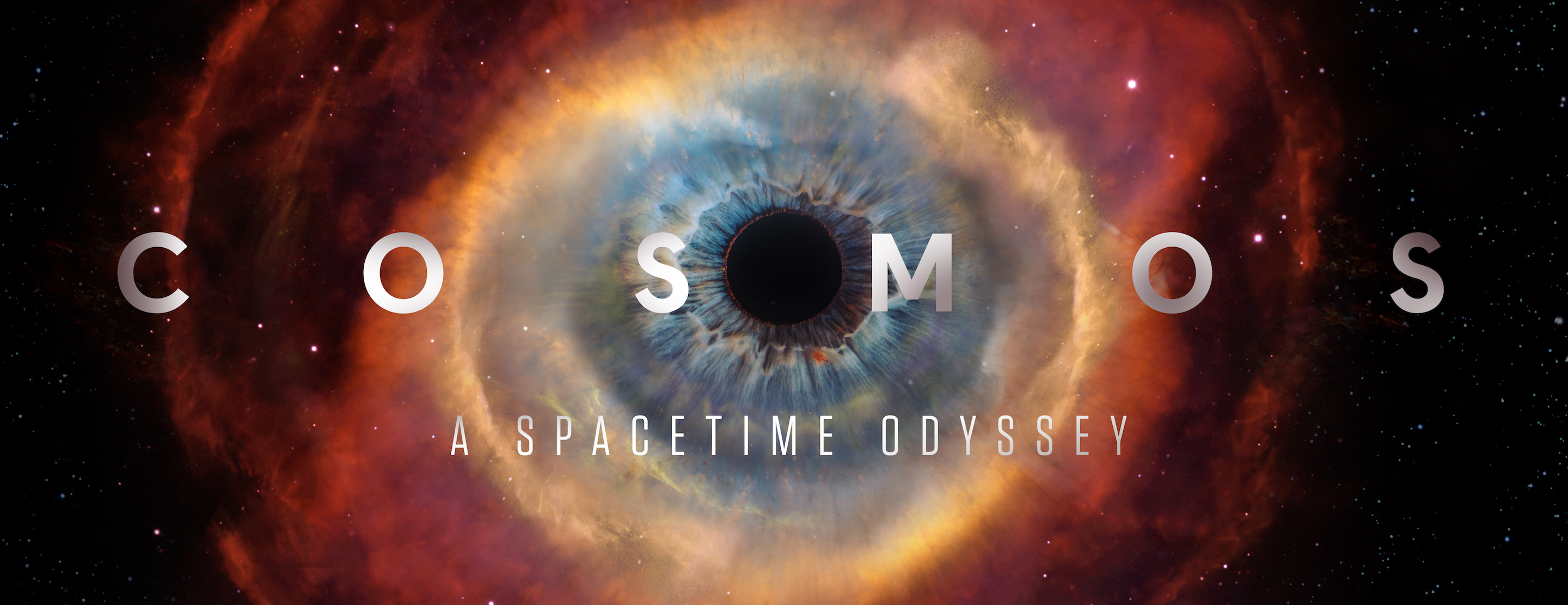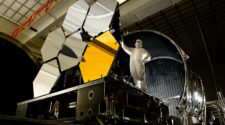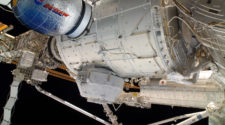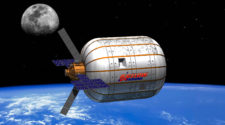“Cosmos: A Spacetime Odyssey” beams onto our television screens on March 9 across 10 U.S. networks, including FOX and National Geographic Channel, with a multi-network simulcast in the United States.
Global releases will follow shortly after on National Geographic and FOX branded channels in 180 countries within a week of the U.S. premiere.
Fronted by famed astrophysicist Neil deGrasse Tyson, the show brings aboard new producer Seth McFarlane, and reunites writers/producers Ann Druyan and Steven Soter who worked with Carl Sagan on the original “Cosmos: A Personal Journey”. Many more heralded creative talents have worked on creating the all new “Cosmos” for science hungry 21st century audiences. Following are teaser synopses of the incredible voyage that awaits us. It’s time to get going again…
Episode 01: STANDING UP IN THE MILKY WAY
The iconic Ship of the Imagination, once piloted by Dr. Carl Sagan has been refitted for a new 21st century voyage across space and time. Its shining legacy has been handed to an old student of Sagan’s, Dr Neil deGrasse Tyson, who takes us – the next generation – on our first steps; a journey to discover our coordinates in space.
As we set sail for the stars a Window On The Past opens in the floor of our Ship and we explore Italy’s Renaissance period meeting Giordano Bruno. A friar and scholar, Bruno first glimpsed the true nature of the Cosmos, but in his time conveying these heretic ideas publicly was dangerous. They even invited death by execution. We learn how his sacrifice, zeal for truth, and zero tolerance for poor evidence and lack of scientific rigour have inspired the generations of scientists who followed him.
Neil continues our voyage and establishes our place in time. On a vast Cosmic Calendar, he shows us that each “month” from January to December represents more than a billion years. As we walk through our cosmic history, we discover that in the last seconds of December 31st, humans appear on this epic stage.
As we learn about the generations of truth seekers, we find that this community of minds stretches back to antiquity, and forward to the stars.
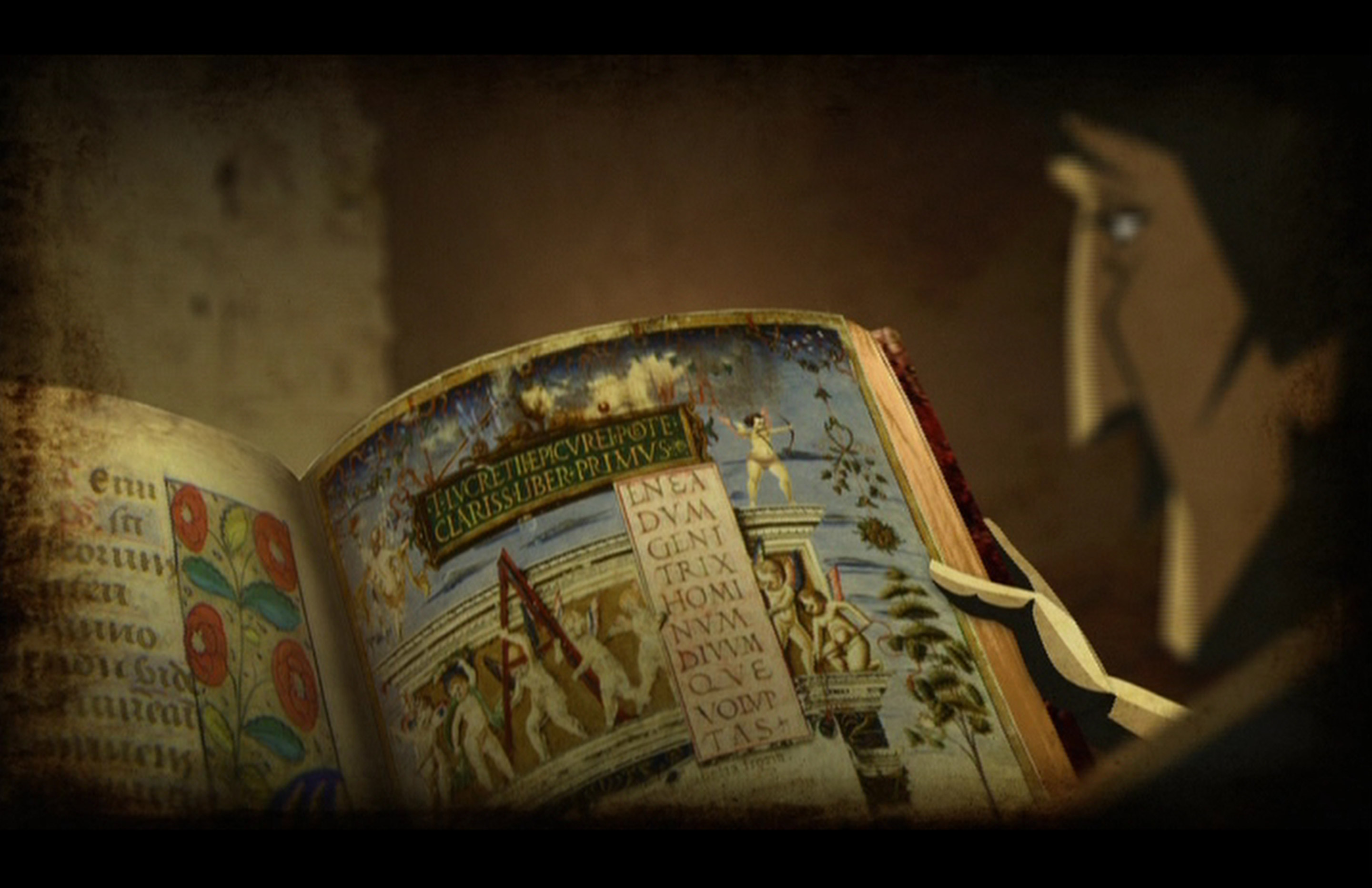
Episode 02: SOME OF THE THINGS THAT MOLECULES DO
Over eons, artificial selection has transformed the wolf into the shepherd. Natural selection has evolved apes into humans. Our Ship of the Imagination continues its journey, now through the epochal layers of evolution to view the story of all life on a majestic cosmic canvas. Neil guides us through the grand Hall Of Extinction; a graveyard for all those species that have been lost through time. The hall’s five corridors commemorate the five great extinction catastrophes experienced by life on Earth. But there is a sixth dark and unnamed corridor. A reminder that our history is evolving and that our story may end down this corridor. These halls are the scattered dead branches from the tree of life.
From our vantage point we see a cataclysmic volcanic eruption 250 million years ago in the ancient super-continent Pangaea. This triggered the Permian Mass Extinction Event where 97% of all life on Earth became extinct. We retrace the tale of those mass extinction survivors from the first single-celled organisms four billion years ago to us.
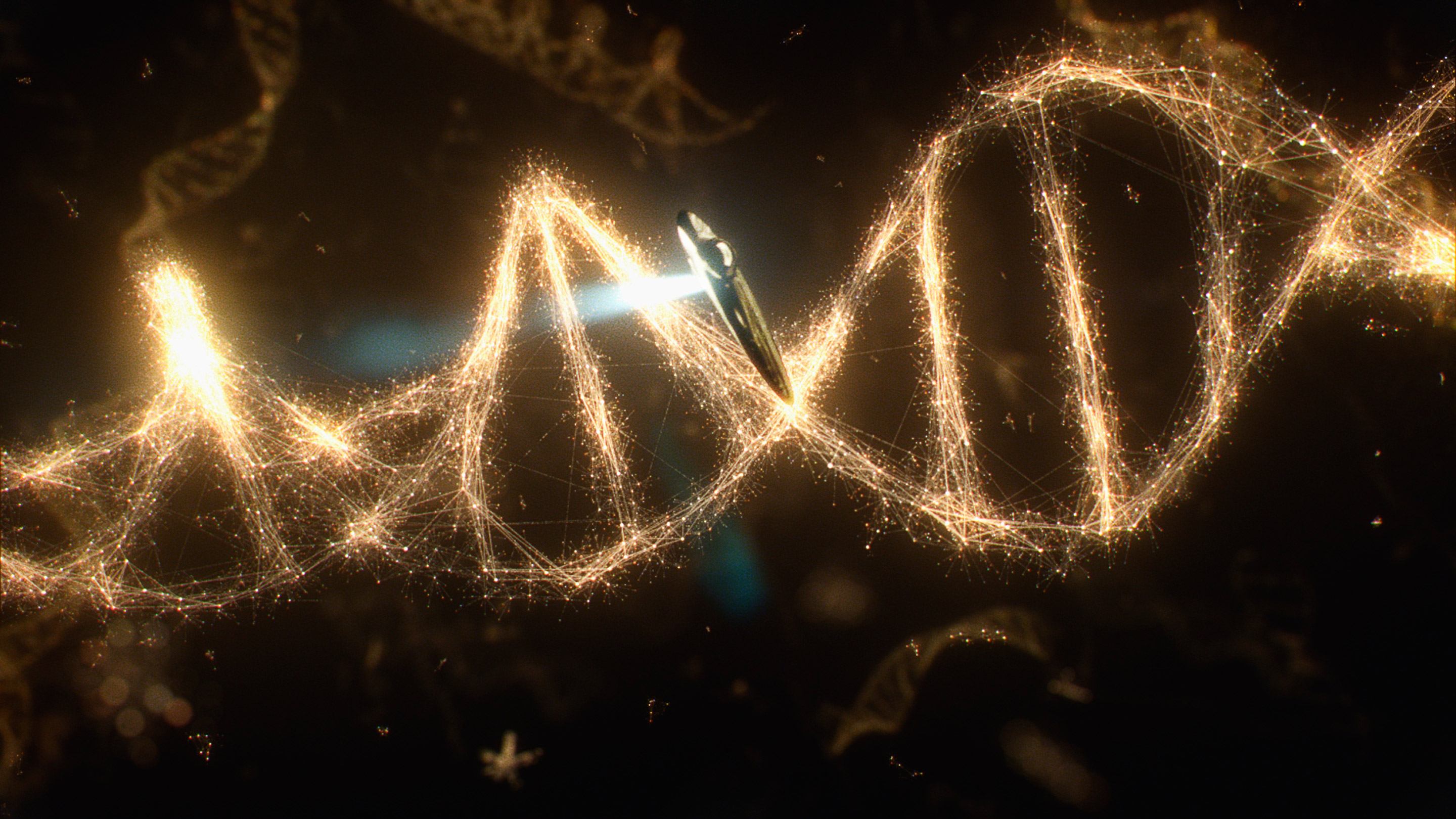
Episode 03: WHEN KNOWLEDGE CONQUERED FEAR
Our Ship of the Imagination is in the dark distant depths of the Oort Cloud, halfway to our nearest celestial neighbour. Trillions of frozen dirty snowballs block our path. Neil pilots us on a rollercoaster ride chasing one of these comets during its fall towards our Sun across a million years.
Our understanding of these astronomic visitors is a result of the friendship between two 17th century geniuses, Edmond Halley and Sir Isaac Newton. Tormented by an intellectual competitor Robert Hooke, Newton was isolated and fearful of sharing his discoveries. Through Halley’s friendship, generous and unfailing support, Newton overcame his fears and published the Principia Mathematica. This three volume masterpiece based on the universal laws of motion, launched the Scientific Revolution. It empowered science to explore the Cosmos and forecast the future.
Our talent for automatic and spontaneous pattern recognition, both true and false, is a gift and a curse. We will examine this double-edged sword as we look back over the history of science. Finally in a nod to Newtonian laws, Neil will open a new Window On The Future in the ceiling of Our Ship to see a far distant and forecasted inevitability. Several billion years from now the Milky Way and Andromeda galaxies will collide, proving Newton’s theories with stunning clarity.

Episode 04: HIDING IN THE LIGHT
On our continuing voyages, we reopen the Window To The Past to see ancient Chinese history, where the first emperor of China violently suppressed free thought and speech with the first known book burning. Travelling westwards and up to the 11th century, we see Europe and Africa during the Golden Age of Islam, when Arabic was the language of mathematics and science. We meet one of that region’s earliest physicists, Ibn al-Haytham. Described as the father of the Scientific Method, through enhanced optics he first understood how we see light and how it travels.
Continuing the themes of light and enlightenment, we discover William Herschel’s breakthroughs on infrared in sunlight, and conclusions on invisible forms of light beyond what we can see. This episode also recites the tale of a poor 19th century Bavarian boy, rescued by royalty, who as an adult discovered unique signatures in starlight. He went on to found the science of astrophysics. His highly guarded discoveries locked away in an ancient abbey would capture the imagination of another genius (the hero of Episode 09), and lead to a world-altering key to the Cosmos itself.
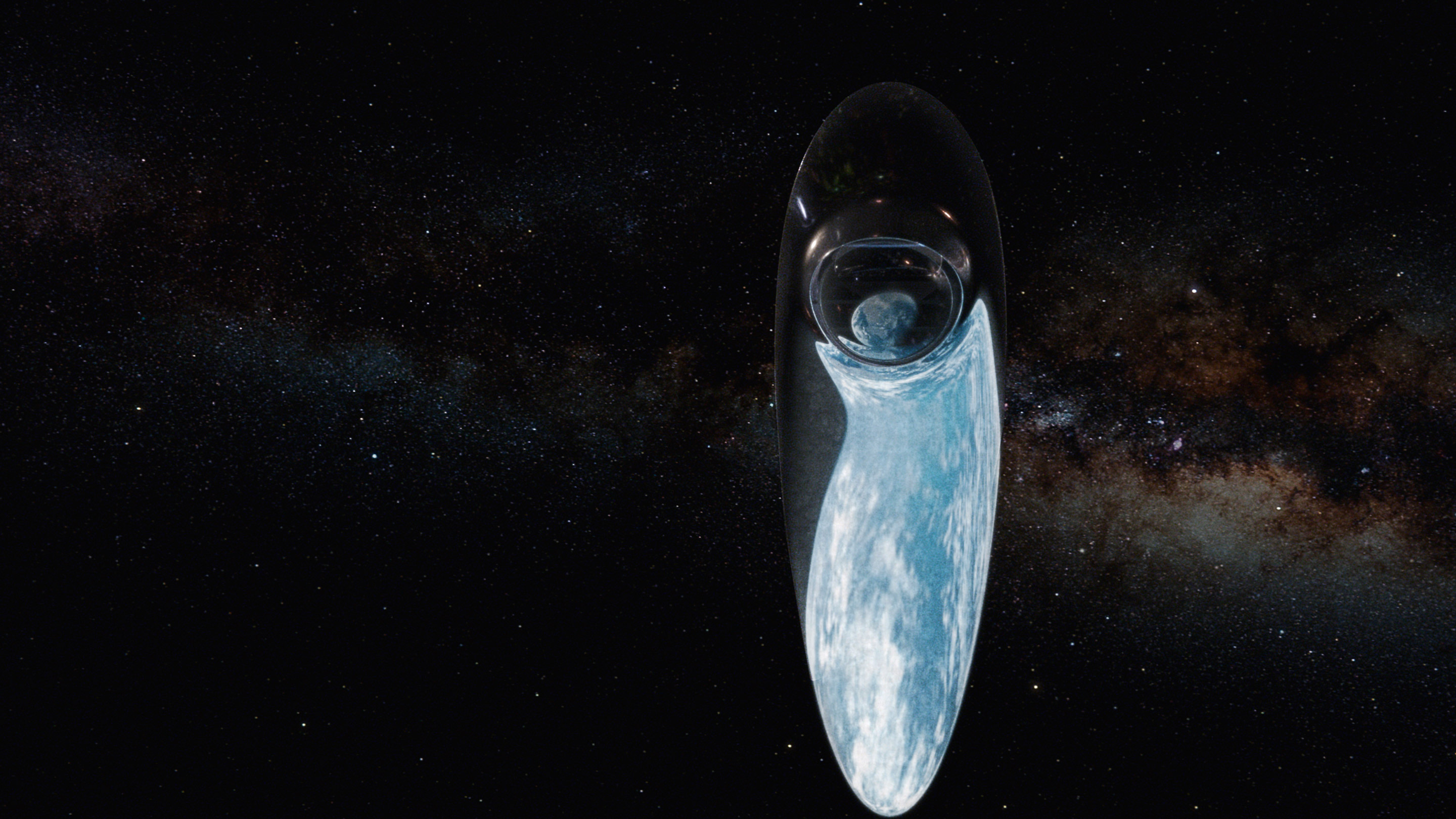
Episode 05: A SKY FULL OF GHOSTS
Pushing forward into new realms, Neil takes us on a new trip into light, time and gravity; and we discover how they warp our universal perceptions.
We meet William Herschel again, a man who revealed that telescopes are time machines looking back into the distant past. We meet his young son John, who inspired by tales from his father will follow in his astronomical footsteps. But an ominous outsider skulks close by. All three are actors in the bizarre play showing how light plays with time and gravity.
Accelerating to near the speed of light, we take our Ship of the Imagination to faraway destinations seen only by telescopes. And for each journey we observe how events and life has unfolded on Earth in our absence. Then we push onwards, to the beginning of space and the very end of time itself.
All of us go about our lives in a gravity well. As toddlers we learn to stand tall against an invisible force that keeps us down. A teenage girl speeds off on her motorbike leaving the taunts of young boys behind. The beautiful Italian countryside whips past her as she experiences the phenomena related to relativistic travel through the Cosmos. But what would happen if the speed of light was infinite?
We change the gravity in New York City to see how it affects the lives of those in the Big Apple. Then we run into the shadowy figure from the late 18th century who concluded that black holes must exist. Taking our Ship of the Imagination to the event horizon of a black hole, we peer inward curiously. But then we are caught inescapably and are drawn over the edge and into it.
What is reality now? Anything must be possible. Time travelling backwards in Neil’s life, we look into the day that changed his world forever. The day he met Carl Sagan…
Episode 06: DEEPER, DEEPER, DEEPER, STILL
Neil dons a Cloak of Visibility and we see him purely as a being composed of atoms. The Ship of the Imagination journeys to micro space – to the bottom of a dewdrop – as we view the strange life there, and the struggle for life they are embroiled in.
Further still, Neil takes us on a journey traversing the complex neural networks in our brains, jumping synapses, from a molecule, to our memories of home. The ultimate scientific truth is that we never truly touch each other and this is shown in a tender love story between a young boy and girl. We look around and view the world differently as we’ve never seen it before. The plants and trees breathe around us.
In an ancient Grecian evening, Democritus tells a magnificent tale of reality’s true nature that has been long since proven. Looking deep into his wine glass we see the intoxicating effects of the carbon atoms in his wine – and why carbon is essential to life on Earth. Neil drives us deeper to the inner chambers of atoms, to the cathedral of the nucleus and onward to the very heart of our Sun itself as we understand fusion.
Voyaging deep into the Earth, to a place unseen by human eyes, we discover the mystery of the neutrino. Our onward path leads us back in time to the Egyptian Temple of Ramses, where the nourishing rays from our star always halt before the Lord of Creation named Ptah. Deeper, deeper and deeper still into the mists of time, we come to that place on the Cosmic Calendar beyond which the unknown beckons – but a great barrier lies between us and the beginning of time itself.
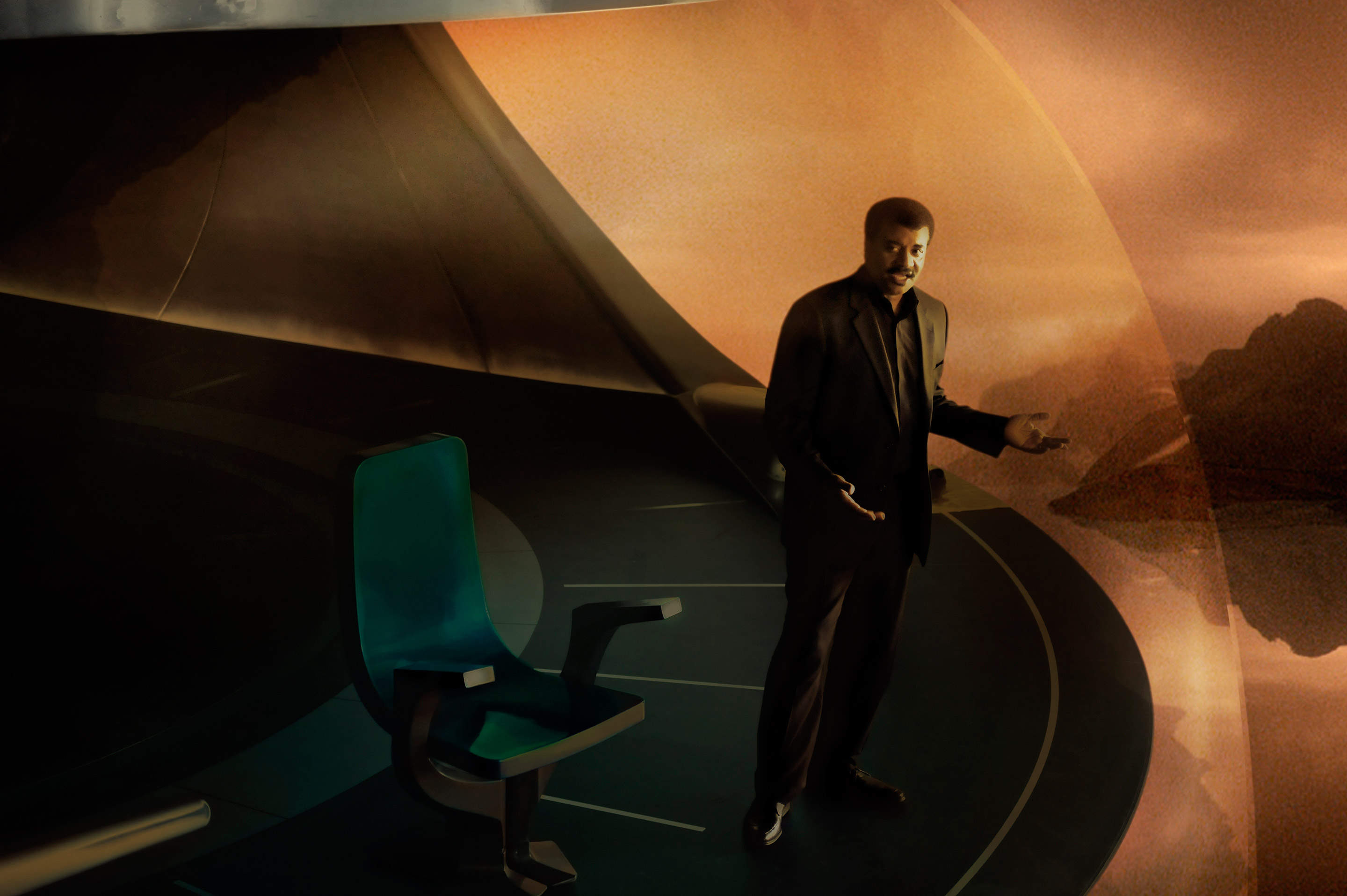
Episode 07: THE CLEAN ROOM
Unsung heroes of science come in all forms, and this tale of a man from Iowa goes back to before the Earth was formed. Even to before the elements themselves were formed in stars. Earth’s constantly changing nature has all but erased this origin tale but how do we know the true age of the Earth?
This story to discover the true age of our terran home spans centuries, until we stumble upon a guy from Iowa who develops an exacting but demanding method to do this. However, in his efforts to determine the truth, he finds a terrible crime has been done. Committed to the search for truth he will not stop, will not rest until the killers are found. Yet as he battles on, his efforts draw in an enemy, a man practiced in the misuse of science…
This grand saga shows us the highs and lows of science over the ages. It illuminates how one person using science as a tool for good can change the world for the better for all of us.
Episode 08: SISTERS OF THE SUN
The Pleiades Constellation – a guide for our ancient forebears. They looked into the night sky and used the Pleiades to invent agriculture. Their improved lot moved them from a people living under the heavens to a people living in dwellings, now disconnected from the stars above them.
Fables and traditions – from Halloween to the native American Kiowa nation’s myth of the Devil’s Tower – they all originated from the Pleiades. The ancient Greeks saw the constellation Orion chasing the Seven Sisters across the night sky. Legends ascribed by human storytellers to give meaning to these distant mysterious points of light.
We hear a new story; that of two 20th century female astronomers at Harvard who counted the stars. A young British lady joined them in their efforts, resisting the world’s leading authority, and she taught the world about the real nature of the stars in our sky. Our Ship of the Imagination takes us on an exploration through stellar lifecycles including our own familiar Sun. Looking up through The Window On The Future we travel to Earth and live through the final ideal day on our mother planet. Exploring farther we stand witness to the tragic death of a binary star system.
In Australia we view the heavens with clarity akin to our ancestors’ experiences. 7,500 light years away we see Eta Carina and its malevolent companion, torturing it with its strong gravity. Torn and twisted not to become a supernova, but one day to light up our skies as a hypernovae.
Neil samples the delights of a Tuscan vineyard showing how sunshine becomes moonshine. As we end this chapter of our travels, he guides us to the planet of a humdrum star orbiting a globular cluster. We see the most beautiful sight never seen until now; not a sunrise but a galaxy rise, as morning is brilliantly transformed not by one sun but two hundred billion suns! This is the rising of our Milky Way.
Episode 09: THE ELECTRIC BOY
Our 21st century world of hi-tech, satnavs, Twitter and Facebook, communication with our robotic ambassadors at the fringes of our solar system – these all are owed to the remarkable genius of Albert Einstein.
We start with Isaac Newton’s problem of why an apple falls. Could this be the same riddle of why the planets are pulled towards the Sun as if on an invisible tether?
We move through Einstein’s early childhood and see how his father sparked Albert’s creative genius with the gift of a compass. How can the needle move if there is nothing but empty space behind it? There must be a deeply hidden reason to this.
We meet young Michael Faraday; born into obscure poverty he rose above his humble beginnings to invent the motor and the generator. He is our bridge from the old world to our world of high tech iPhones and computer tablets. Caught in the middle of 19th century English class warfare, he rose to scientific prominence, placing truth and ethics above all else, and rejected Queen Victoria’s highest honours to make him a Knight of the Realm. His devotion to his mentor Sir Humphry Davy and his wife Sarah; his establishment of public science education for children; his personal struggle with poor mental health; and redemptive breakthrough with Field Theory, are all milestones in his incredible, yet honest life.
On our journey through the past we encounter two strange beings, whose discoveries preceded Faraday’s by centuries, and the fortunate child who converted Faraday’s words into equations forming the basis of our society’s reliance on electronic media and communication.
Episode 10: THE LOST WORLDS OF PLANET EARTH
The Ship of the Imagination takes us on a tour through space and time, to all new frontiers, to grasp the history of Earth, writ small in its atoms, to the monumental scale of its oceans, continents, and the variety of inhabitants on our globe.
Visiting the primeval Carboniferous Era we encounter giant dragonflies and plants soaring hundreds of feet high. Yet this world will ensnare humans millions of years later. The arrival of lignin in the carbon cycle allows trees to take root, irrevocably altering the environment of our young planet forever. Our trek takes us to a world of purple oceans and green skies – ours; and we dive into an ocean – in Texas…
We meet the genius who solved an ancient geological mystery but died before being accepted by his peers. And we’ll meet the lady who proved his discoveries to be correct and exposed the largest feature on Earth. Diving Our Ship beneath the waves we’ll explore the largest oceanic mountain range and descend into a mammoth underwater canyon where life has found a way to thrive in the dark cold. And the wonders around us continue to reveal themselves as we take the Ship of the Imagination into the Earth’s mantle itself.
The young Earth was a rapidly changing series of worlds, active and destructive. We are just the latest inhabitants in its long history of renewal. We will recreate these old worlds and travel forward in our Ship of the Imagination to an older Earth, a quarter of a billion years in our far future.
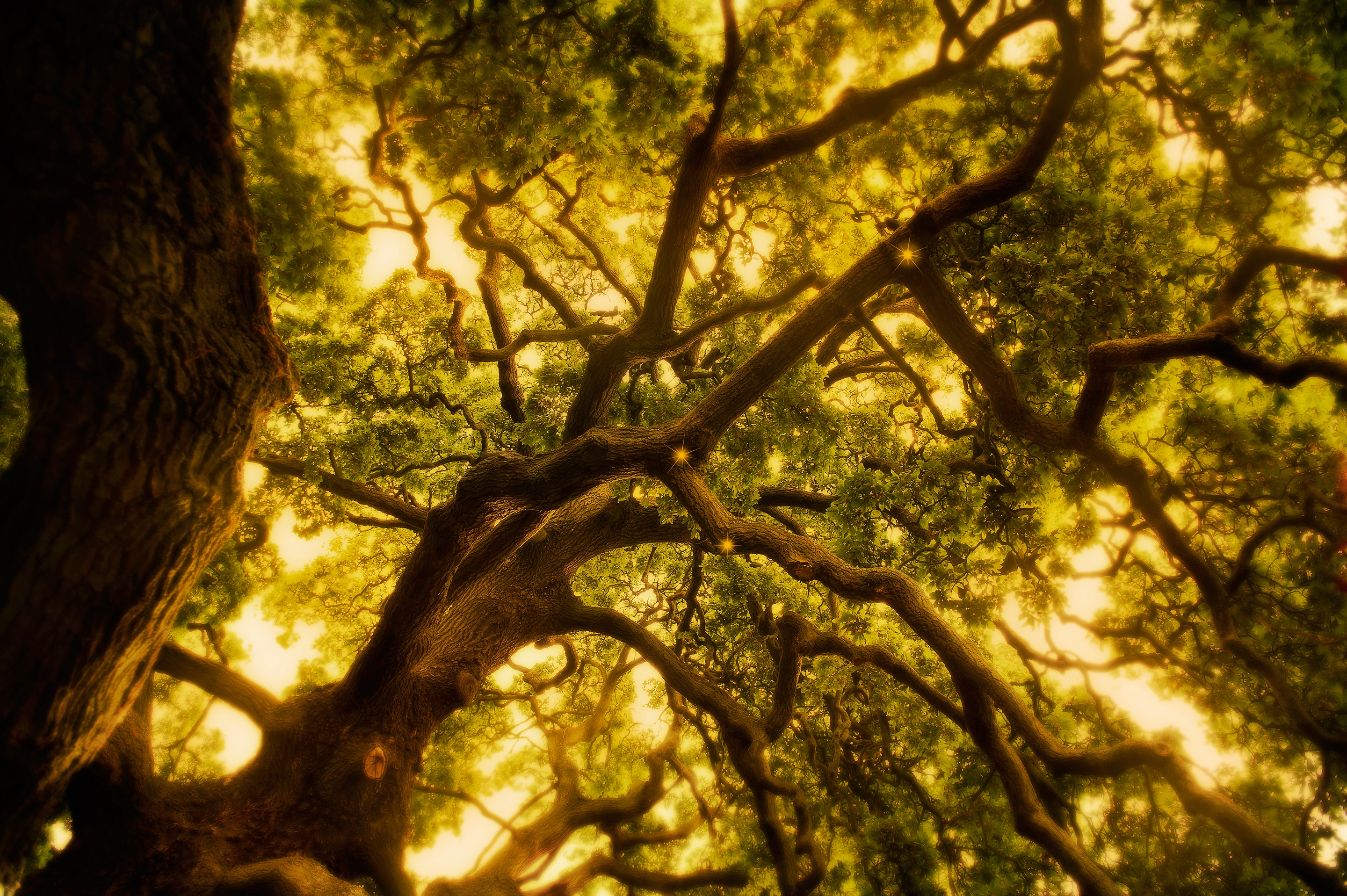
Episode 11: THE IMMORTALS
Must we die? What must it be like to live forever? If there were timeless beings such as these in the Cosmos, what would their infinite existence be like across space and time?
To answer this question, we first visit the young and beautiful Akkadian Princess Enheduanna as she sails down the Euphrates River in 2300 B.C. Her place in history is forever immortalised by the words she wrote. 5,000 years after she passed away, she lives on, remembered by her poem of a goddess of love triumphant over the universe. Enheduanna is the first key in understanding the diverse interpretations of immortality.
The grand walls of Uruq (Iraq) rise up as we meet the heroic Gilgamesh. His personal journey is a quest for immortality. He meets a sage named Utnapushtim, who was instructed to build an ark, a millennium before Noah.
These historical figures have their own immortality thousands of years after their time as stories are written and reinterpreted across the generations. Their lives are coded within our own DNA.
More timeless stories have been given to us through the ages. An early 20th century meteorite strike in a remote Egyptian village held a story, but we could not read it for seventy years. Not until we sent our robot ambassadors to Mars and learned the language of the Red Planet. Immortality is preserved in our migrations from one place to the next. Life moves between planets and perhaps across the Cosmos itself.
1946: We record our first attempt to contact extra-terrestrial life. See what happened to that message. Great civilisations rise and fall. We ask do they have finite lifespans? We look at intelligent life on our own planet through the lens of a new Drake Equation and conclude the possibility of intelligent life across the whole observable universe.
We ponder about intelligent beings living in Red Dwarf star systems for trillions of years. How would they evolve over this seemingly infinite time? Would they unlock new doors to becoming the new immortals? We revisit the Cosmic Calendar of a future unseen and live through the first seconds of January 1st in a new Cosmic Year.
Episode 12: THE WORLD SET FREE
A serene beach, a perfect day, but this is not our home. Welcome to Venus, but not as we know it, for this is Venus of old. Over time a runaway greenhouse effect inflicts mayhem on the planet’s ecology, boiling off its great oceans, creating immense surface pressures 92 times that of Earth, and turning the sky into a poisonous fume.
Safe inside our Ship of the Imagination, we survey this hellish wasteland before Neil flies us back to Earth to scale a huge structure built by a small life form. England’s White Cliffs of Dover are seen as precious vaults of carbon.
Charles David Keeling reveals the Earth as one living breathing sphere. One breath happens annually. We examine the changing nature of Earth’s atmosphere, our effect on it and explore the ramifications of global warming.
We look back at the long story of global warming and developing alternative energies as a remedy. Taking Our Ship through time we view critical points in Earth’s history and choose to intervene. The Paris Exposition of 1878 is a major part of this story as Augustin Mouchot adapts his solar concentrator dish to printing presses and ice-making machines. In similar fashion, Frank Shuman exhibits his own irrigation machine in the Egyptian desert, powered by the Sun. And we visit Albert Einstein and Mileva Maric diligently working to solve the photo-electric effect. This is the key to all solar technologies.
And yet we have failed to listen to the story of science. It was science that heralded our technological age of advancements and enabled the impossible to become possible. We remember how, as Neil pilots our Ship of the Imagination in chase of the legendary Apollo 8 mission, on a date with destiny at the Moon.
Should we wake up from our slumber we will have a far superior world and existence for us and our progeny. Neil takes us on a dazzling ride to the resplendent future that is at our fingertips.
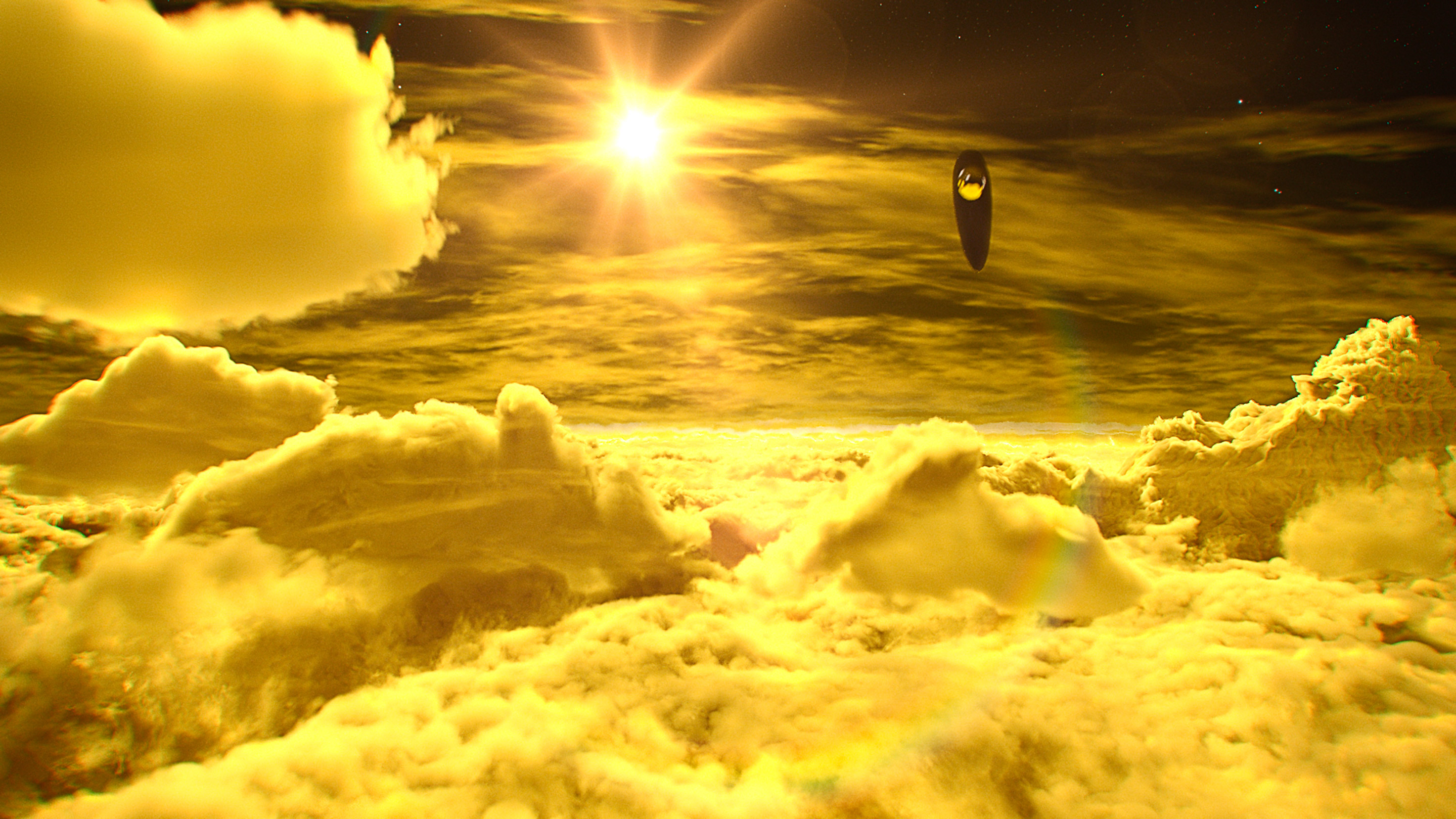
Episode 13: UNAFRAID OF THE DARK
On our voyages through space and time we have journeyed from the heart of an atom to the observable cosmic horizon, from the dawn of time itself to a future far far away. Now we are ready for an experiment. If thought through and performed correctly the grand understanding of our Cosmos is the ultimate reward.
In the 15th century, Martin Behaim created the first mapped globe of our world, months before Christopher Columbus set sail for Asia, but discovered the New World. Behaim’s understanding of his then incomplete Earth was far more than our understanding of the Cosmos now. We take to the skies in Viktor Hess’ hot air balloon and uncover the unknown cosmic rays. We visit the great Egyptian Library of Alexandria, a repository and magnet for the world’s knowledge. Boarding our Ship of the Imagination for a final time we meet the crazy conundrum that is Fritz Zwicky, forecaster of supernovas, neutron stars, gravitational lensing and the mysterious dark matter.
It is dark matter’s existence that is proving most elusive. The fearless Vera Rubin solved the mystery in the 1950’s with her unique view. She looked at the stars anew and realised they were just foam on the crest of the wave; the true ocean was still out there and still unknown. All that we know, all that we think we know, a hundred billion galaxies, their innumerable stars, planets, moons – add them up and in all of human history we only have found a mere 4% of the unknown…
So much is still out there, and the vastness of this humbles us. It gives us much needed perspective that is absent from other human endeavours. Yet we have always been curious explorers, and the rich mysteries that call for our attention cannot be ignored. There is a hidden force in the universe that overwhelms gravity and is pushing the Cosmos apart. We cannot see it, but we know it is there waiting to be found.
Of all of our explorations, only two robotic ambassadors from Earth, Voyager 1 & 2 have travelled the vast distances to reach the cosmic shoreline at the ocean of interstellar space. The Voyagers transformed our understanding of astronomy with their epic travelogues from the depths of our Solar System. Yet perhaps their greatest gift was a simple one; an image of Earth from beyond Saturn, a Pale Blue Dot. Carl Sagan’s legacy from the Voyager missions was this hard won image, an image which reframes our species’ cosmic consciousness. Our signature messages on the Voyager Interstellar Golden Record will live on a billion years from now in a galaxy of untold possibilities.
As we come to the end of our “Spacetime Odyssey,” we look back on the philosophy of science and how it is an uplifting and spiritual experience for all.
Please be sure to check out the rest of our “Cosmos” coverage, as well as share our content with your friends and family. (The social sharing buttons are just below the headline on the right side.) Let’s make “Cosmos: A Spacetime Odyssey” a worldwide phenomena.
- Cosmos receiving largest ever global TV launch
(FOX and National Geographic Channel will be premiering the show in 180 countries.) - Wonders of the Cosmos: Neil deGrasse Tyson answers readers’ questions
(Our very own question and answer session with the famed astrophysicist.) - Neil deGrasse Tyson is a conduit to knowledge
(Exclusive article on what it was like to work alongside him on “Cosmos.”) - Ann Druyan preserves the legacy of Sagan’s “Cosmos” with “A Spacetime Odyssey”
(Another exclusive perspective from the show’s research coordinator.)

